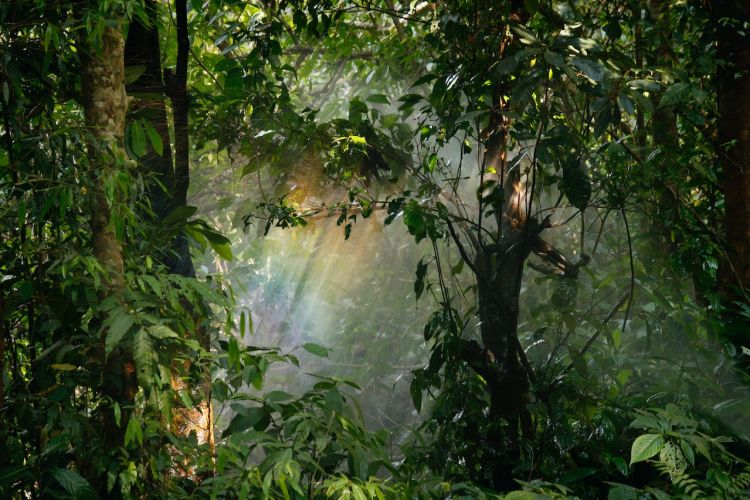Tropical forests approach critical high-temperature threshold, but there is still time to act

A new study finds that the world’s tropical forest canopies may be closer to critical high-temperature thresholds than previously thought, but climate change mitigation can help to avoid them.
The study combines satellite thermal and experiment data from the world’s tropical forests to look at the variation of leaf temperatures within forest canopies.
It found that a small percentage of tropical leaves are already reaching and exceeding the temperatures at which they can no longer function.
As climate change continues, entire canopies could die.
The findings have serious implications – tropical forests are home to most of the world’s biodiversity and are key regulators of our climate.
The study was led by Dr Chris Doughty of Northern Arizona University. It’s co-authored by Professor Emanuel Gloor of the School of Geography, alongside collaborators from the University of Oxford, University of California, Université de Montpellier among others.
Unexpected results
The study, titled ‘Tropical forests are approaching critical temperature thresholds,’ was published on August 23rd 2023 in Nature.
Among the key results is an estimation of the number of leaves approaching critical temperatures under future increases in air temperatures of 2°, 3° and 4 °C.
These are the various warming scenarios under climate change.
The highest leaf temperatures increased by 8°C.
“We were really surprised that when we warmed leaves by 2, 3 or 4 °C, the highest leaf temperatures increased by 8°C.
This is a non-linear feedback that we were not expecting,” said Dr Doughty, Associate Professor of Ecoinformatics.
More than 1% of the leaves in the warming experiments exceeded critical temperature thresholds, estimated at 46.7 °C, at least once a year.
This is a times-two increase in the percentage of leaves that currently exceed the threshold.
Measuring canopy temperatures
To overcome previous challenges in measuring tropical forest leaf and canopy temperatures, the team used a variety of innovative research methods.
They combined ground-based measurements of individual tropical leaf temperatures, leaf warming experiments from three continents and data from a new NASA thermal imaging instrument on the International Space Station.
The team built a comprehensive understanding of tropical forest leaf temperatures and created a model of expected temperature change alongside global warming.
Professor Gloor and Dr Sophie Fauset, a former post-doctoral student at the University of Leeds who is now based at the University of Plymouth, contributed the dataset for Brazil.
New NASA instrument
The team used a new NASA instrument, the ECOsystem Spaceborne Thermal Radiometer Experiment on Space Station (ECOSTRESS) to measure canopy top peak temperatures.
They took the temperatures of all tropical forests in South America, Africa and Southeast Asia. They found that during dry, warm periods, entire canopies could exceed 40°C.
The ECOSTRESS provides the highest combination of spatial and temporal thermal imagery ever obtained.
“Historically, we have either studied individual trees to gather data at small scales or used satellite instruments to gather data at large scales.
“What was missing was a way to collect data at small scales across the tropics. That’s where we turn to satellite remote sensing.
“We were able to measure the temperature of the trees directly at incredibly high resolution, all the way from space, using thermal infrared sensing,” said study co-author Dr Joshua Fisher.
Dr Fisher launched the ECOSTRESS satellite while working at NASA five years ago. He’s now an Associate Professor of Environmental Science and Policy at Chapman University.
Simulated warming scenarios
With high-resolution leaf and canopy temperature datasets captures, the study simulated the fate of tropical forests under future climate change warming scenarios.
While tropical forest ecosystems are already relatively very warm, previous research has suggested that they are not acclimated to wide temperature swings.
They assessed the impact of increased air temperatures and accounted for the possibility of more frequent drought incidences.
Droughts further elevate air temperatures, reduce plants’ evaporative cooling ability and accelerate leaf temperatures and tree mortality.
As leaves died in the model, they could no longer provide additional cooling, which increased warming even more.
Under the most likely scenarios, the model predicted that tropical forests could withstand up to 3.9 °C of additional climate change-driven warming.
With some basic climate change mitigation, the tropics can avoid this fate.
“Our model projections are not destiny,” Dr Doughty said.
“It suggests that with some basic climate change mitigation, the tropics can avoid this fate.
“It helps pinpoint a few key areas that need further research, like whether tropical trees can change their upper-temperature thresholds.”
The Amazon is at greater risk
The research found that because the Amazon is already experiencing higher temperatures than the Congo basin, it is at greater risk.
As tropical forests’ role in housing species diversity and regulating the planet’s climate, insights into their future can build an understanding of the trajectory of the planet.
The worst-case scenarios are more than preventable
The authors emphasize that these worst-case scenarios are more than preventable: the world can act now.
Dr Doughty says, “by avoiding high-emissions pathways and deforestation, we can protect the fate of these critical realms of carbon, water, and biodiversity.”




